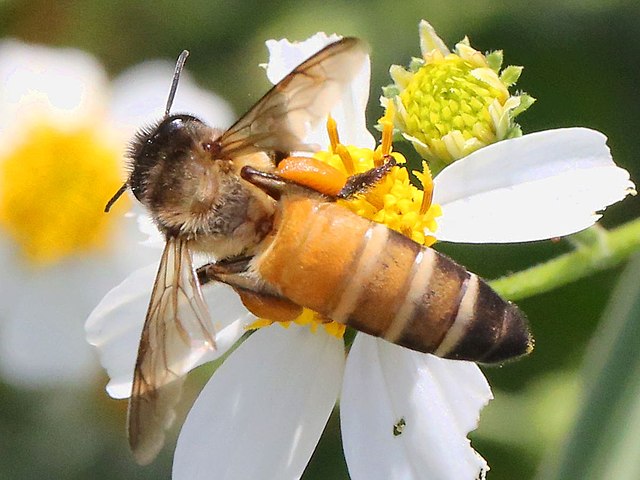Знаете ли вы, что смена сезонов влияет на ваше здоровье, настроение и даже гены? Узнайте, как жить в гармонии с...
Невероятные и всеобъемлющие факты о пчелах: больше, чем мед и жало
Когда вы думаете о пчеле, что приходит вам на ум? Мед, жало или, может быть, назойливое жужжание? Приготовьтесь к тому, что ваш мир перевернется. Пчелы — это не только удивительные насекомые, но и жизненно важные инженеры для нашей экосистемы и нашего собственного выживания. В этом всеобъемлющем руководстве мы отправимся в их таинственный мир и откроем факты, которые навсегда изменят ваше мировоззрение.

Удивительные факты вкратце
- Одна треть пищи, которую мы едим, прямо или косвенно зависит от опыления пчелами.
- Пчелы используют «виляющий танец», чтобы сообщить друг другу точное местоположение источников пищи.
- Обоняние медоносной пчелы в 50 раз сильнее, чем у собаки, и ее даже можно научить обнаруживать болезни!
- Чтобы произвести полкилограмма меда, пчелиная семья пролетает расстояние, эквивалентное двум кругосветным путешествиям.
1. Мир пчел: больше, чем один вид
Вы можете не поверить, но в мире насчитывается более 20 000 видов пчел! Медоносная пчела (Honey Bee) — лишь один из них. Пчелы в целом делятся на три основные категории:
- Общественные пчелы (Social Bees): такие как медоносные пчелы и шмели (Bumblebee), которые живут в организованных колониях.
- Одиночные пчелы (Solitary Bees): эта категория составляет большинство видов. Каждая самка в одиночку строит гнездо и откладывает яйца (например, пчела-каменщица).
- Паразитические пчелы (Parasitic Bees): эти пчелы откладывают свои яйца в гнезда других пчел, чтобы их потомство было выращено хозяином.
Гордость Ирана, порода «Меда» (A.M. Meda): Среди различных пород медоносных пчел в Иране есть своя местная порода под названием «Меда», происходящая с гор Эльбурс и центрального Ирана. Эта порода имеет особое значение благодаря своей приспособленности к климатическим условиям Ирана.
2. Колония: разумный суперорганизм
Пчелиная колония функционирует как единое, разумное существо, называемое суперорганизмом. У каждого члена есть определенная задача, которая служит выживанию колонии. В этом обществе существует три типа пчел (касты):
Матка: бьющееся сердце улья
Матка — единственная мать колонии, и ее основная задача — откладывать яйца. На пике своей активности она может откладывать до 2000 яиц в день! Матка контролирует поведение и гармонию всего улья, выделяя особые феромоны.
Рабочая пчела: опора колонии
Эти самки пчел отвечают за всю работу в улье, и их обязанности меняются в зависимости от возраста:
- Кормилица (Nurse): ухаживает за личинками и кормит их.
- Строитель (Builder): строит восковые соты с инженерной точностью.
- Охранник (Guard): защищает вход в улей от захватчиков.
- Уборщик (Cleaner): поддерживает чистоту в улье.
- Сборщик (Forager): опасная работа по сбору нектара, пыльцы и воды за пределами улья.
Трутень (Drone): короткоживущие принцы
Единственная цель самцов пчел (трутней) — спаривание с матками из других колоний. У них нет жала, они не участвуют в работах улья и умирают после спаривания. Осенью рабочие пчелы изгоняют их из улья, чтобы сохранить запасы пищи на зиму.
3. Язык танца и сложная коммуникация
У пчел одна из самых сложных систем коммуникации в животном мире.
Виляющий танец (Waggle Dance): самое удивительное поведение медоносной пчелы! Когда пчела-сборщица находит богатый источник пищи, она возвращается в улей и исполняет особый танец в форме восьмерки, чтобы передать точную информацию другим:
Угол танца по отношению к солнцу указывает направление к источнику пищи.
Продолжительность танца определяет расстояние до него от улья.
Помимо танцев, они используют феромоны (химические запахи) для отправки предупреждающих сигналов, идентификации матки и объявления тревоги.
4. Жало: последнее средство защиты
Распространенное заблуждение заключается в том, что пчелы агрессивны. На самом деле, медоносная пчела жалит только тогда, когда чувствует угрозу своей жизни или жизни своей колонии. Для медоносной пчелы ужаление стоит жизни, так как ее зазубренное жало застревает в коже, и часть ее брюшка отрывается вместе с ним. Поэтому ужаление — это ее последнее средство защиты.
5. Экономическое значение: невидимые столпы сельского хозяйства
Ценность пчел выходит далеко за рамки производства меда. Опыление пчелами ежегодно приносит мировой экономике миллиарды долларов. Подсчитано, что одна треть всей потребляемой человеком пищи прямо или косвенно зависит от опыления этими насекомыми. Такие культуры, как миндаль, яблоки, клубника, кофе и огурцы, зависят от пчел для своего производства.
6. Серьезные угрозы и неопределенное будущее
К сожалению, эти ценные существа сталкиваются с серьезными угрозами. Популяции пчел по всему миру сокращаются по следующим причинам:
- Пестициды: indiscriminate use of pesticides, especially neonicotinoids, disrupts the nervous systems of bees.
- Клещ Варроа (Varroa Mite): этот крошечный паразит — главный враг медоносной пчелы во всем мире. Питаясь телом пчелы, он передает вирусы и уничтожает колонию.
- Изменение климата и разрушение среды обитания: исчезновение разнообразных лугов и цветущих растений ограничило источники пищи для пчел.
7. Таблица фактов и характеристик медоносной пчелы
Здесь представлены некоторые ключевые характеристики различных типов медоносных пчел в сравнении:
| Характеристика | Матка (Queen) | Рабочая пчела (Worker) | Трутень (Drone) |
|---|---|---|---|
| Продолжительность жизни | 2-5 лет | 2-6 недель (летом) | Около 5 недель |
| Количество глаз | 5 | 5 | 5 (крупнее, чтобы найти матку) |
| Основная задача | Откладка яиц (до 2000 в день) | Все работы в улье | Спаривание |
| **Жало** | Есть (гладкое, без зазубрин) | Есть (зазубренное, одноразовое) | Нет |
| **Количество в колонии** | 1 | 10 000 - 60 000 | Несколько сотен (сезонно) |
8. Как мы можем помочь пчелам?
Защита пчел — это общая обязанность. Вы тоже можете сыграть эффективную роль простыми действиями:
- Сажайте местные цветы: сажайте в своем саду или горшках дружественные пчелам цветы, такие как лаванда, подсолнухи и клевер.
- Избегайте пестицидов: не используйте химические пестициды в своем саду.
- Обеспечьте неглубокий источник воды: пчелы тоже хотят пить. Неглубокая тарелка с водой и несколькими камешками, на которые они могут приземлиться, поможет им.
- Поддерживайте местных пчеловодов: покупая местный мед и продукты пчеловодства, вы помогаете поддерживать здоровые пчелиные семьи.





















Последние комментарии